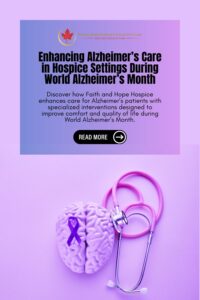
- By: administrator
- Blog
- No Comments
World Alzheimer’s Month in September brings a critical focus on the challenges and needs of Alzheimer’s patients, particularly those in hospice care. In Los Angeles, where the demand for specialized dementia care is growing, Faith and Hope Hospice is at the forefront of offering compassionate and tailored interventions that significantly enhance the quality of life for Alzheimer’s patients. This blog explores the unique challenges these patients face and the specific strategies implemented by Faith and Hope Hospice to address these needs effectively.
Understanding Alzheimer’s in Hospice Care
Alzheimer’s disease progresses through several stages, each presenting its own set of challenges. In its advanced stages, the focus shifts towards providing comfort and quality of life, as curative treatment options diminish. Hospice care becomes crucial at this stage, offering support that is attuned to the complexities of the disease.
Challenges Faced by Alzheimer’s Patients in Hospice:
– Cognitive Decline: Patients may experience severe memory loss, confusion, and difficulty communicating.
– Behavioral Changes: Symptoms can include agitation, restlessness, and sometimes aggression.
– Physical Deterioration: As the disease progresses, patients may lose the ability to walk, sit up, or perform daily tasks independently.

Specialized Interventions by Faith and Hope Hospice
Faith and Hope Hospice is committed to providing comprehensive and specialized care for Alzheimer’s patients. Each intervention is carefully designed to address the unique symptoms and challenges posed by the disease, ensuring the highest quality of life possible within the hospice care setting.
Personalized Care Plans: Our approach starts with detailed assessments to create personalized care plans that respond to the specific needs of each Alzheimer’s patient. This includes:
- Advanced Symptom Management: We prioritize effective management of common Alzheimer’s symptoms such as agitation and sleep disturbances. Techniques might include medication management, environmental modifications, and personalized routines that promote calm and familiarity.
- Pain Management: Recognizing pain in Alzheimer’s patients, who may not be able to communicate verbally, requires keen observation and expertise. Our staff is trained to identify pain through non-verbal cues and implement appropriate interventions to relieve discomfort without excessive reliance on pharmacological solutions.
- Nutritional Support: Ensuring proper nutrition can be challenging as Alzheimer’s progresses. Our team provides personalized dietary plans that consider each patient’s preferences, dietary restrictions, and ability to eat, helping maintain nutritional health and comfort.
Therapeutic Activities: Engagement is key in managing Alzheimer’s symptoms. Our therapeutic activities are designed to enhance cognitive function and emotional well-being:
- Sensory Stimulation: Activities, such as music therapy, are used to soothe and engage patients, reducing stress and promoting relaxation.
- Memory Care Activities: Tailored to individual cognitive levels, these activities might include looking through photo albums, simple crafts, or reminiscence therapy, which encourages patients to share stories and memories, reinforcing their sense of identity and history.
Behavioral Support Strategies: Behavioral issues can be particularly distressing for both patients and their families. Our specialized strategies include:
- Individualized Behavior Plans: Understanding triggers and creating environments that reduce distress and confusion. This might involve structured routines, elimination of fall risks, and use of calming colors and decorations in the patient’s room.
- Communication Techniques: Staff are trained in communication strategies that are effective and compassionate, using simple, reassuring phrases and maintaining eye contact to help reduce anxiety and confusion in patients.
Support for Families and Caregivers: Recognizing that Alzheimer’s disease is a family journey, we extend our support to include the entire family:
- Caregiver Training: Educating caregivers on how to manage daily care challenges, understand disease progression, and communicate effectively with their loved ones.
- Psychosocial Support: Offering counseling and support groups that help families navigate the emotional landscape of Alzheimer’s care, providing a space for sharing experiences and strategies.
Conclusion:
As we observe World Alzheimer’s Month, Faith and Hope Hospice remains committed to enhancing the care of Alzheimer’s patients in Los Angeles through specialized hospice interventions. By focusing on individualized care plans, comprehensive family support, and community engagement, we strive to improve the comfort and quality of life for those affected by this challenging disease.
Contact Faith and Hope Hospice:
If you or a loved one are facing Alzheimer’s and need support, please reach out to Faith and Hope Hospice in Los Angeles for compassionate care tailored to your needs.
Phone: (626) 869-2151
Website: https://faithandhopehospice.com
Check the related blog here: https://faithandhopehospice.com/world-alzheimers-month-and-hospice-care-navigating-the-journey-with-compassion-and-understanding/
